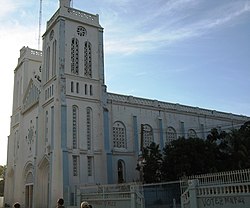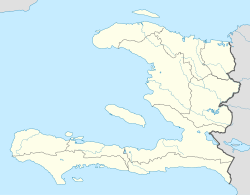Les Cayes (/leɪ ˈkeɪ, leɪ ˈkaɪ/ lay K(A)Y, French: [le kaj]), often referred to as Aux Cayes (French: [o kaj]; Haitian Creole: Okay), is a commune and seaport in the Les Cayes Arrondissement, in the Sud department of Haiti, with a population of 71,236.[1] Due to its isolation from the political turmoil of the capital, Port-au-Prince, it is one of Haiti's major ports, with export trade concentrating on mostly coffee and sugarcane. As the world's largest supplier of vetiver, it exports 250 tons annually of this ingredient of perfume and fragrance manufacturing.[2][3][4][5] Minor exports include bananas and timber.
Les Cayes
Okay (Haitian Creole) Aux Cayes | |
|---|---|
 Les Cayes Cathedral | |
| Coordinates: 18°12′0″N 73°45′0″W / 18.20000°N 73.75000°W | |
| Country | Haiti |
| Department | Sud |
| Arrondissement | Les Cayes |
| Population (2015) | |
• Total | 86,780 |
| Time zone | UTC-5 (Eastern) |
| • Summer (DST) | UTC-4 (Eastern) |
History
editEuropean settlement
editThe island of what was known by the Spanish as Hispaniola was inhabited for thousands of years by indigenous peoples. The first European settlement in the southwest area was the town of Salvatierra de la Sabana, founded by the Spanish explorer Diego Velázquez de Cuéllar[6] in 1504. Vasco Núñez de Balboa was a co-founder of this town and lived there for several years trying to raise pigs as a business. Balboa gave up that enterprise and left the town hiding in a barrel of a Spanish expedition going to explore the Gulf of Uraba, Panama. Vasco Núñez de Balboa, later on 25 September 1513 would discover the South Sea, today known as the Pacific Ocean. This settlement was abandoned in 1540.
The area was uninhabited until the French colonial administration founded the town of Aux Cayes ("On the cayes"), so named due to its proximity to Île-à-Vache. The town was destroyed twice by hurricanes in 1781 and 1788. In July 1793, the whites in Les Cayes were massacred.[7]
Asylum for independent insurgencies
editSimón Bolívar arrived in Les Cayes on 24 December 1815,[8] and on 2 January 1816 was introduced to Alexandre Pétion, President of the Republic of Haiti by a mutual friend[9] seeking assistance for his insurgency against the Spanish colonial government in Venezuela.[10] Bolívar and Pétion impressed and befriended each other and,[11] after Bolívar pledged to free every slave in the areas he occupied, Pétion gave him money and military supplies.[12][13]
Mexican nationalists, Francisco Javier Mina and José Joaquín de Herrera took asylum in Les Cayes and were welcomed by Pétion during the Mexican War of Independence.[14]
United States occupation of Haiti
editOn 5 December 5 1919, American planes bombed Les Cayes in a possible act of intimidation. American pilots were investigated for their actions, though none were condemned. These actions were described by anthropologist Jean-Philippe Belleau as possibly "the first ever carried out by air on civilian populations".[15]
President Herbert Hoover had become increasingly pressured about the effects of occupying Haiti at the time and began inquiring about a withdrawal strategy.[16] By 1929, Haitians had grown angered with the Borno-Russell government and American occupation, with demands for direct elections increasing.[16] In early December 1929, protests against the American occupation began at the Service Technique de l’Agriculture et de l’Enseignement Professionnel's main school.[16] On December 6, 1929, about 1,500 Haitians peacefully protesting local economic conditions in Les Cayes were fired upon by U.S. Marines, with the massacre resulting in 12 to 22 Haitians dead and 51 injured.[15][16][17][18][19] The massacre resulted in international outrage, with President Hoover calling on Congress to investigate conditions in Haiti the following day.[16][20]
Natural disasters
editIn the wake of the 12 January 2010 earthquake, the Cuban military set up a field hospital in the region.[21]
On 4 October 2016, Hurricane Matthew made landfall in Les Cayes causing severe damage.[22]
On 14 August 2021, a magnitude 7.2 earthquake occurred near the city. It was the largest earthquake to strike Haiti in modern history, even stronger than the 2010 earthquake near the Haitian capital.[23] The earthquake killed over 2,200 people and injured around 12,700 others, most of them in Les Cayes and its surrounding areas.[24]
Tourism
editLes Cayes plays a significant role in the still under-developed Haitian tourism industry, with pleasant sights such as: Gelée Beach: one of the longest and most visited beaches in Haiti. The white sand beach of Gelée beach is very popular in Haiti, not only for its restaurants which serve typical southern Haiti dishes such as tonm-tonm, grilled-conch, grilled-fish and lobster, but also for hosting an annual music festival around mid-August which usually features some of the best Compas music bands. Many visitors both from within Haiti and neighboring USA will come spend the weekend in Les Cayes. As the number of tourists continues to grow, several new hotels and restaurants continue to pop up.
The Botanical Garden of Les Cayes (Jardin Botanique des Cayes, in French) is located in Bergeau, at the northern entrance of the city. The site occupies an area of eight (8) hectares. Other places of interest to tourists are the nearby Île à Vache, Pic Macaya, Saut-Mathurine falls and Kounoubois cave in Camp-Perrin, Pointe-de-Sable beach in Port-Salut, Marie-Jeanne cave in Port-a-Piment and Arrondissement Aquin where Fort des Oliviers, Fort Anglais and Bonnet Carré can be found in the town of Saint Louis du Sud.
Facilities
editAirport
editLes Cayes has an airport, Antoine-Simon Airport. As of 1 February 2013, the first stone on the expansion project of the Antoine-Simon Airport in Les Cayes had been laid. The project to make Antoine-Simon a viable international airport is part of broader efforts aiming at ramping up infrastructure development in the south.[25]
The expansion project will add a new 3,000-metre runway and a new terminal to the airport. Haitian officials Prime Minister Laurent Lamothe and Tourism Minister Stéphanie Villedrouin suggested that the airport would open up completely the Southern Region as the country saw tourism as one of the promising sectors capable of creating thousands of new jobs in the region.[26]
Another airport project is also planned for the neighbouring island of Île-à-Vache.[27]
University
editLes Cayes has some training centers of which The American University of the Caribbean, Haiti; The Public University of The South in Les Cayes, (UPSAC); and The Law and Economics School of Les Cayes (EDSEC).
Hospital
editHôpital Immaculée Conception (Immaculate Conception Hospital, also referred to as HIC-Cayes), is the public hospital for Les Cayes and the South Department. Its facilities include an emergency department, maternity ward, and a dental clinic.
Sport
editLes Cayes is home to professional football clubs, America des Cayes and FC Juventus des Cayes.
Notable natives and residents
edit- John James Audubon, French-American naturalist
- Euphémie Daguilh, Royal mistress to the Haitian emperor Jean-Jacques Dessalines
- Jean Joseph Maurice Dartigue (1903-1983), Minister of Public Instruction, Labor, and Agriculture from 1941 until 1945
- Auguste Davezac, United States Ambassador to the Netherlands
- André Corvington, Olympic fencer
- André Rigaud, Haitian revolutionary leader, was born here on a plantation.
- Assotto Saint, writer and artist
- Horace Pauleus Sannon (1870-1938) was a Haitian historian and politician and presidential candidate in 1926 and 1930[28]
Villages
editReferences
edit- ^ "IHSI" (PDF). 'Institut Haïtien de Statistique et d’Informatique. Retrieved 29 August 2014.
- ^ Frager, Haiti: shortening the perfume chain to become world number one Archived 12 September 2022 at the Wayback Machine, International Trade Centre, International Trade Forum - Issue 3/2001
- ^ The Guardian, ed. (4 March 2014). "Perfume manufacturers must cope with the scarcity of precious supplies". The Guardian. Retrieved 12 April 2015.
- ^ Adams, David (24 April 2014). "FEATURE-Perfumers promote fair trade for Haiti's 'super-crop'". Reuters. Retrieved 12 April 2015.
- ^ FIDA, ed. (2014). "Did you know? Haiti is one of the World's Leading Vetiver Producers". Retrieved 12 April 2015.
- ^ Floyd, Troy (1973). The Columbus Dynasty in the Caribbean, 1492-1526. Albuquerque: University of New Mexico Press. p. 63.
- ^ Franklin W. Knight; Colin A. Palmer (1989). The Modern Caribbean. UNC Press Books. p. 32. ISBN 978-0-8078-4240-9. Retrieved 27 July 2013.
- ^ Slatta & de Grummond 2003, p. 129; Langley 2009, p. 59; Arana 2013, p. 178.
- ^ Masur 1969, p. 192; Slatta & de Grummond 2003, p. 130; Lynch 2006, p. 97; Langley 2009, p. 59; Arana 2013, pp. 178–179.
- ^ Jean-Bertrand Aristide (1996). Dignity. University of Virginia Press. p. 191. ISBN 978-0-8139-1674-3.
- ^ Masur 1969, pp. 192–193; Slatta & de Grummond 2003, p. 130; Arana 2013, p. 179.
- ^ Masur 1969, p. 193; Slatta & de Grummond 2003, p. 130; Lynch 2006, p. 97; Arana 2013, p. 179.
- ^ McFarlane 2014, p. 313.
- ^ "Antecedentes". embamex.sre.gob.mx. Retrieved 17 September 2020.
- ^ a b Belleau, Jean-Philippe (25 January 2016). "Massacres perpetrated in the 20th Century in Haiti". Sciences Po. Archived from the original on 2 June 2021. Retrieved 28 May 2021.
- ^ a b c d e Munro, Dana G. (1969). "The American Withdrawal from Haiti, 1929–1934". The Hispanic American Historical Review. 49 (1): 1–26. doi:10.2307/2511314. JSTOR 2511314.
- ^ Pezzullo, Ralph (2006). Plunging Into Haiti: Clinton, Aristide, and the Defeat of Diplomacy. University Press of Mississippi. pp. 77–100. ISBN 9781604735345.
- ^ U.S. Haiti Rebellion 1918 Archived June 1, 2013, at the Wayback Machine, On War
- ^ Danticat, Edwidge (28 July 2015). "The Long Legacy of Occupation in Haiti". The New Yorker. Archived from the original on 20 May 2021. Retrieved 2 June 2021.
- ^ "1929: Cayes Massacre". Arizona Daily Star. 22 April 2021. Archived from the original on 2 June 2021. Retrieved 2 June 2021.
- ^ Caribbean Net News, "Cuba to open fifth field hospital in Haiti" [permanent dead link], 5 February 2010. Accessed 5 February 2010
- ^ Haïti: Premier bilan après le passage de l'ouragan Matthew. SOS Children's Villages International (Report) (in French). ReliefWeb. 7 October 2016. Retrieved 7 October 2016.
- ^ "undefined".
- ^ "Death toll from Haiti earthquake rises to 2,248". BERNAMA. 9 July 2021. Archived from the original on 7 September 2021. Retrieved 7 September 2021.
- ^ Caribbean Journal "Haiti Lays First Stone on Expansion of Airport in Les Cayes "
- ^ Caribbean Journal "Haiti Lays First Stone on Expansion of Airport in Les Cayes "
- ^ Caribbean Journal "Haiti Lays First Stone on Expansion of Airport in Les Cayes "
- ^ Schutt-Ainé, Patricia (1994). Haiti: A Basic Reference Book. Miami, Florida: Librairie Au Service de la Culture. p. 106. ISBN 0-9638599-0-0.
- ^ "Location" (Map). Google Maps. Retrieved 27 August 2014.
External links
edit- Les Cayes-related website
- "Port-Salut: bien sur, mais...", Le Nouvelliste, in French, article on differences between Les Cayes and Port Salut
